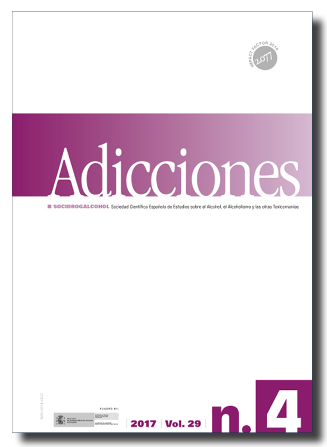Working on a Standard Joint Unit: A pilot test
DOI:
https://doi.org/10.20882/adicciones.721Keywords:
Cannabis, 9-Tetrahydrocannabinol, standard unit, pilot study.Abstract
Introduction. Assessing cannabis consumption remains complex due to no reliable registration systems. We tested the likelihood of establishing a Standard Joint Unit (SJU) which considers the main cannabinoids with implication on health through a naturalistic approach. Methodology. Pilot study with current cannabis users of four areas of Barcelona: universities, nightclubs, out-patient mental health service, and cannabis associations. We designed and administered a questionnaire on cannabis use-patterns and determined the willingness to donate a joint for analysis. Descriptive statistics were used to analyze the data. Results. Forty volunteers answered the questionnaire (response rate 95%); most of them were men (72.5%) and young adults (median age 24.5 years; IQR 8.75 years) who consume daily or nearly daily (70%). Most participants consume marihuana (85%) and roll their joints with a median of 0.25 gr of marihuana. Two out of three (67.5%) stated they were willing to donate a joint. Conclusion. Obtaining an SJU with the planned methodology has proved to be feasible. Pre-testing resulted in an improvement of the questionnaire and retribution to incentivize donations. Establishing an SJU is essential to improve our knowledge on cannabis-related outcomes.References
Aleixandre, N. L., del Río, M. P. y Pol, A. P. (2004). Estrategias de afrontamiento: factores de protección en el consumo de alcohol, tabaco y cannabis. Adicciones, 16, 1–6.
Coffey, C., Lynskey, M., Wolfe, R. y Patton, G. C. (2000). Initiation and progression of cannabis use in a population-based Australian adolescent longitudinal study. Addiction, 95, 1679–1690. doi:10.1046/j.1360-0443.2000.951116798.x
Cuenca-Royo, A. M., Sánchez-Niubó, A., Forero, C. G., Torrens, M., Suelves, J. M. y Domingo-Salvany, A. (2012). Psychometric properties of the CAST and SDS scales in young adult cannabis users. Addictive Behaviors, 37, 709–715. doi: 10.1016/j.addbeh.2012.02.012
Delegación del Gobierno para el Plan Nacional sobre Drogas. (2009). Consumo problemático de cánnabis en estudiantes españoles de 14-18 años: Validación de escalas. Madrid: Ministerio de Sanidad, Servicios Sociales e Igualdad. Recuperado de http://www.pnsd.msssi.gob.es/profesionales/publicaciones/catalogo/bibliotecaDigital/publicaciones/pdf/ConsProblematico_cannabis.pdf
Delegación del Gobierno para el Plan Nacional sobre Drogas. (2013). Encuesta Estatal sobre el Uso de Drogas en Enseñanzas Secundarias (ESTUDES) 2012-2013, España. Madrid: Ministerio de Sanidad, Servicios Sociales e Igualdad. Recuperado de http://www.pnsd.msssi.gob.es/noticiasEventos/dossier/pdf/ESTUDES2012_2013.pdf
Delegación del Gobierno para Plan Nacional sobre Drogas. (2015). Encuesta sobre alcohol y drogas en España (EDADES) 2013/14. Madrid: Ministerio de Sanidad, Servicios Sociales e Igualdad. Recuperado de http://www.pnsd.msssi.gob.es/profesionales/sistemasInformacion/sistemaInformacion/pdf/EDADES2013.pdf
Di Forti, M., Morgan, C., Dazzan, P., Pariante, C., Mondelli, V., Marques, T. R., … Murray, R. M. (2009). High-potency cannabis and the risk of psychosis. The British Journal of Psychiatry, 195, 488–491. doi:10.1192/bjp.bp.109.064220
EMCDDA. (2004). Cannabis problems in context — understanding the increase in European treatment demands. Lisbon: Office for Official Publications of the European Communities. Recuperado de http://www.emcdda.europa.eu/html.cfm/index34898EN.html
González, M. P., Sáiz, P. A., Quirós, M. y López, J. L. (2000). Personalidad y uso-abuso de cannabis. Adicciones, 12, 185–196.
Hall, W. (2015). What has research over the past two decades revealed about the adverse health effects of recreational cannabis use? Addiction, 110, 19–35. doi: 10.1111/add.12703
Hall, W. y Degenhardt, L. (2009). Adverse health effects of non-medical cannabis use. Lancet, 374, 1383–91. doi:10.1016/S0140-6736(09)61037-0
Legleye, S., Karila, L., Beck, F. y Reynaud, M. (2007). Validation of the CAST, a general population Cannabis Abuse Screening Test. Journal of Substance Use, 12, 233–242. doi:10.1080/14659890701476532
Mariani, J. J., Brooks, D., Haney, M. y Levin, F. R. (2011). Quantification and comparison of marijuana smoking practices: Blunts, joints, and pipes. Drug and Alcohol Dependence, 113, 249–251. doi:10.1016/j.drugalcdep.2010.08.008
Mechoulam, R. y Gaoni, Y. (1964). Isolation, Structure, and Partial Synthesis of an Active Constituent of Hashish. Jounal of the American Chemical Society, 86, 1646–1647.
Miller, W. R., Heather, N. y Hall, W. (1991). Calculating standard drink units: international comparisons. Addiction, 86, 43–47. doi:10.1111/j.1360-0443.1991.tb02627.x
Norberg, M. M., Mackenzie, J. y Copeland, J. (2012). Quantifying cannabis use with the Timeline Followback approach: A psychometric evaluation. Drug and Alcohol Dependence, 121, 247–252. doi:10.1016/j.drugalcdep.2011.09.007
Rodríguez-Martos Dauer, A., Gual Solé, A. y Llopis Llácer, J. J. (1999). La «unidad de bebida estándar» como registro simplificado del consumo de bebidas alcohólicas y su determinación en España. Medicina Clínica, 112, 446–450.
Stockwell, T., Blaze-Temple, D. y Walker, C. (1991). The effect of “standard drink” labelling on the ability of drinkers to pour a “standard drink”. Australian Journal of Public Health, 15, 56–63.
U.S. Department of Health and Human Services. (2014). A Letter to Parents | National Institute on Drug Abuse (NIDA). Recuperado de http://www.drugabuse.gov/publications/marijuana-facts-parents-need-to-know/letter-to-parents
United Nations Office on Drug and Crime. (2009). Recommended methods for the identification and analysis of cannabis and cannabis products. New York: United Nations. Recuperado de https://www.unodc.org/documents/scientific/ST-NAR-40-Ebook.pdf
United Nations Office on Drugs and Crime. (2015). World Drug Report 2015. New York: United Nations. Recuperado de https://www.unodc.org/documents/wdr2015/World_Drug_Report_2015.pdf
Van der Pol, P., Liebregts, N., Brunt, T., van Amsterdam, J., de Graaf, R., Korf, D. J., … van Laar, M. (2014). Cross-sectional and prospective relation of cannabis potency, dosing and smoking behaviour with cannabis dependence: An ecological study. Addiction, 109, 1101–1109. doi:10.1111/add.12508
Van der Pol, P., Liebregts, N., de Graaf, R., Korf, D. J., van den Brink, W. y van Laar, M. (2013). Validation of self-reported cannabis dose and potency: an ecological study. Addiction, 108, 1801–1808. doi:10.1111/add.12226
Villalbí, J. R., Suelves, J. M., Saltó, E. y Cabezas, C. (2011). Valoración de las encuestas a adolescentes sobre consumo de tabaco, alcohol y cannabis en España. Adicciones, 23, 11–16.
Walden, N. y Earleywine, M. (2008). How high: quantity as a predictor of cannabis-related problems. Harm Reduction Journal, 5, 20. doi:10.1186/1477-7517-5-20
World Medical Association Declaration of Helsinki. (2013). Ethical Principles for Medical Research Involving Human Subjects. The Journal of the American Medical Association, 310, 2191–2194.
Zeisser, C., Thompson, K., Stockwell, T., Duff, C., Chow, C., Vallance, K., … Lucas, P. (2012). A “standard joint”? The role of quantity in predicting cannabis-related problems. Addiction Research & Theory, 20, 82–92. doi:10.3109/16066359.2011.569101








